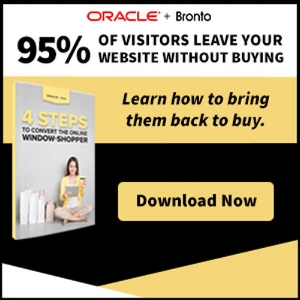4 Ways Canadian Retailers Can Create Loyalty and Drive Revenue
/By Greg Zakowicz, Senior Commerce Marketing Analyst at Oracle + Bronto
Amazon may be increasing its Canadian presence, but Canadian ecommerce is still losing more than half its business to retailers outside the country. Smartphones have increased connections between consumers and brands and their access to products is nearly constant – and unrestricted. It’s no surprise that with increased exposure, consumer expectations have evolved. Consumers now expect more from the brands they engage with. Not only do they count on the same features as before, like quality, consistency and reliability, they now also expect relevance, affordable and speedy shipping – as well as excellent customer service. That’s a lot to expect from retailers – they certainly have their work cut out for them.
Canadian retailers now face two challenges: How do they keep ecommerce dollars domestic, and how do they foster loyalty among consumers? One strong solution: Email engagement and relevance. Consumers expect marketing emails to be relevant, but according to a recent report by Fluent, only 15% of them find them to be consistently useful. And because brands often have limited internal resources to execute a sophisticated segmentation strategy, they then turn to batch-and-blast methods, sending the same message to everyone. This email strategy makes it impossible to consistently deliver relevant content to consumers, and it does little to create engagement and cultivate loyalty.
Fortunately, all is not lost. Here are a few tried and true tips that can help connect your brand with consumers – even if you have limited internal resources available.
Product recommendations: Intuitive product recommendations provide relevance to your emails, even if you batch-and-blast. These recommendations will be specific to the subscriber, consider purchase and browse activity, email message content and any specific business rules you’ve set up. The more specific to the individual subscriber you can be, the more personalized the product recommendations will feel to your customer.
Browse recovery: Subscribers who browse your site but fail to place a product in their cart are no longer lost revenue opportunities. Browse recovery messages are targeted, automated messages sent to subscribers who do exactly that – and direct them back to where they were shopping. This tactic is lesser-known but quickly growing in popularity with retailers. Implementing browse-recovery creates emails that are relevant to your subscriber – creating a sense of personalization – and drives revenue for retailers. Now, more than 60% of consumers expect browse behavior to be used to make emails more relevant – and more personal.
Imagine shopping for a new desk. You visit three websites, view some related products, but abandon your session. The next day you receive an email from all three companies. Two are batch-and-blast, full of random assorted office products, while the other showcases the desks that you spent the most time on – the very type of desk you’re looking for. Which message would you click on? Where would you shop?
This is the power of browse recovery.
If you’re going to send your subscriber an email regardless, why not make it one that is relevant and based on their actual interests versus one that is a standard batch-and-blast?
Post-purchase (and other lifecycle messages): You need to send automated messages based on user action, such as a welcome series for new subscribers, in order to capture primary engagement moments. Post-purchase messaging is a great example of how lifecycle messages can help build loyalty. Nurturing your customers, and their purchases, at this critical time provides a level of personalization that only strengthens the retailer-customer bond. This step is essential in improving your customer’s opinion of your brand and making them want to do business with you, again and again. Messages that thank the customer, offer product care or how-to tips and tricks and other helpful messages can be the difference between a one-time purchase and a lifelong customer.
Buy-online-pickup-instore (BOPIS): If you have brick-and-mortar stores, utilizing BOPIS can be an important differentiator. Consumers today want immediacy after making a purchase – they just don’t want to pay for it. This is why Amazon offers two-day – and two-hour – delivery. But this is exactly where stores can compete and take the fight to Amazon. BOPIS allows customers to have the convenience of online purchasing, while also benefiting from the immediacy of receiving the product. An important factor to consider? Sixty-five percent of consumers purchase additional items when picking up orders in-store.
Competition is fierce, global and – for consumers – almost instantly accessible. As consumers continue to rely on their smartphones to search for and purchase products, creating – and keeping – loyalty is more important than ever. Being relevant and engaging with your audience is what will ultimately separate your brand from competitors. Only 15% of consumers find marketing emails consistently relevant. What would your subscribers say about yours?
Greg Zakowicz - As a former consultant with more than 10 years of experience in email, mobile and social media marketing, Greg Zakowicz has first-hand knowledge about the challenges facing the retail industry. Now, as Senior Commerce Marketing Analyst at Oracle + Bronto, he provides thoughtful insight to the Internet Retailer Top 1000, and is a frequent speaker at ecommerce events. Follow him at his website or Twitter @WhatsGregDoing.
Oracle + Bronto arms high-growth retailers with sophisticated marketing automation to maximize revenue opportunities. The Bronto Marketing Platform powers personalized multichannel content that generates the higher engagement needed for retail success. Keenly focused on the commerce marketer, Bronto continues its long-standing tradition as a leading email marketing provider to the global Internet Retailer Top 1000 and boasts a client roster of leading brands, including Rebecca Minkoff, Timex, Lucky Brand, Theory, Brooks, Ashley Homestore and Christopher & Banks. For more information visit bronto.com.
Partner content. To work with Retail Insider, contact Craig Patterson at: craig@retail-insider.com.







![Retail-insider-NRIG-banner-300-x-300-V01-3[2].jpg](https://images.squarespace-cdn.com/content/v1/529fc0c0e4b088b079c3fb6d/1593476525034-QRWBY8JUPUYFUKJD2X9Z/Retail-insider-NRIG-banner-300-x-300-V01-3%5B2%5D.jpg)
![Retail-insider-NRIG-banner-300-x-300-V01-2[2].jpg](https://images.squarespace-cdn.com/content/v1/529fc0c0e4b088b079c3fb6d/1593476491497-W6OZKVGCJATXESC9EZ0O/Retail-insider-NRIG-banner-300-x-300-V01-2%5B2%5D.jpg)
![Retail-insider-NRIG-banner-300-x-300-V01-4[2].jpg](https://images.squarespace-cdn.com/content/v1/529fc0c0e4b088b079c3fb6d/1593476508900-TJG5SNQ294YNOCK6X8OW/Retail-insider-NRIG-banner-300-x-300-V01-4%5B2%5D.jpg)